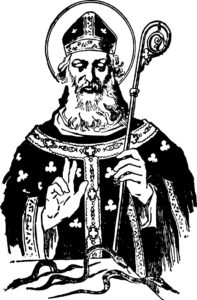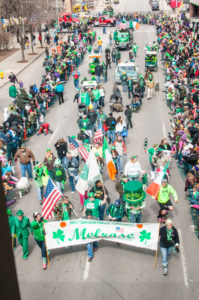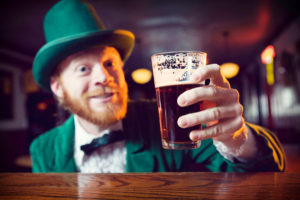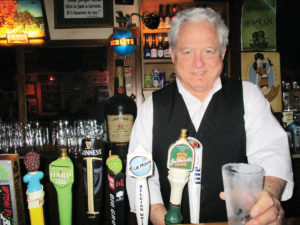The Good, The Bad and The Irish
2/28/2018What’s corned beef got to do with it?
St. Patrick’s Day is one of America’s great celebrations of ethnic pride and alcohol consumption. To most people here, it has much to do with shamrocks, green beer, leprechauns and corned beef with cabbage. The celebration took off in 1947 when the first St. Patrick’s Day parade in New York City was launched; although, Shamrock, Texas, has been hosting a parade since 1938. Ireland only began such parades in 1960. St. Patrick’s Day is an official government holiday in Ireland, but in America it remains an unofficial holiday party celebration along with Super Bowl Sunday and Halloween. What’s it all about?
St. Patrick, the man and the legend
 St. Patrick himself is better known for legends that arose a couple of centuries after his fifth century death than for the things he surely did accomplish. He was born of Roman parents stationed in Great Britain but was kidnapped into slavery and taken to Ireland for six years before escaping and finding passage back to Britain. Two writings that survived him were his spiritual autobiography “Confesio” and his “Letter to Coroticus,” which was a denouncement of the way that Brits treated Irish Christians. Patrick would return again to Ireland after having a dream described in his autobiography. He likely contributed significantly to the Christianization of the Picts and Anglo-Saxons there. His writings today are praised, even by his critics, for their spiritual intensity and moral faith.
St. Patrick himself is better known for legends that arose a couple of centuries after his fifth century death than for the things he surely did accomplish. He was born of Roman parents stationed in Great Britain but was kidnapped into slavery and taken to Ireland for six years before escaping and finding passage back to Britain. Two writings that survived him were his spiritual autobiography “Confesio” and his “Letter to Coroticus,” which was a denouncement of the way that Brits treated Irish Christians. Patrick would return again to Ireland after having a dream described in his autobiography. He likely contributed significantly to the Christianization of the Picts and Anglo-Saxons there. His writings today are praised, even by his critics, for their spiritual intensity and moral faith.
None of that makes a story like the legends that he drove the snakes out of Ireland to their death in the sea, and that he cultivated the shamrock, now the official flower of Ireland, to demonstrate the Holy Trinity to his converts. He is the patron saint of Ireland, and his holy day is celebrated on March 17 each year.
America changes St. Patrick’s Day

The Friendly Sons of St. Patrick holds a parade for St. Patrick’s day in downtown Des Moines each year. Photo by Michael Blair
In America, St. Pat’s Day is a celebration anywhere there is an Irish heritage or significant population. Chicago celebrates by dying the Chicago River green. That city has several parades in different neighborhoods. Shamrock’s parade is a veritable horse show, because it’s Texas.
In Des Moines, the Friendly Sons of St. Patrick is a philanthropic group that raises money through hosting a parade and St. Patrick’s 5K and 10K runs, disc golf, ball golf, Halfway to St. Patrick’s Day bike ride and a bags tournament. This year’s parade will begin at noon on March 17. There will be a queen selected by then, and groups and communities will strut their pride in hopes of winning an award. The biggest of those, “Best in Parade,” has been dominated by Melrose, “Iowa’s Little Ireland,” for years. However, it might be wide open this year because Melrose is having its first ever St. Patrick’s reunion on the same day.
St. Patrick’s Day is, above all, known in America as a celebration of drinking. This represents an unfortunate image that many have of the Irish that’s no truer than the banishment of the snakes. Ireland does have one of the highest rates of alcohol consumption in Western Europe. The Irish Health Board claims that 54 percent of Irish engage in dangerous drinking annually compared to a 28 percent average in the rest of Western Europe. Ireland is nowhere close to most East European countries though in heavy drinking. In fact, the top five most drunken nations on earth, according to Market Watch, are Romania, Russia, Lithuania, Moldova and Belarus.
The alcohol gene

Today, Irish Catholics have been assimilated into the general population of America, and the old images are often considered derogatory and insulting.
Because Ireland is also known as a nation of bards, the drinking is embraced, sometimes elegantly. Irish journalist John Waters wrote: “Drinking in Ireland is not simply a convivial pastime, it is a ritualistic alternative to real life, a spiritual placebo, a fumble for eternity, a longing for heaven, a thirst for return to the embrace of the Almighty.” Irish drinking patterns are, he wrote, “evidence of a deep hole in the Irish psyche which only alcohol can fill.”
Other Irish writers consider that the Irish DNA regards heavy drinking as a justifiable consequence of 400 years of persecution and poverty under Colonial rule. To numb the pain of hunger and humiliation, the peasantry drank home-distilled “poitin,” made from potatoes or grain. In an 18th century report, it’s stated that every second cottage in Ireland had a “poitin” still, which could legally produce up to 12 gallons of “uisgue beatha” (Irish whiskey) at a time. (Whiskey is spelled two ways — with an “e” for Eire, to announce that it is not taxed by the British crown like Scotch whisky is. That carried to North America where most Bourbon takes the Irish spelling and Canadian whisky the British one.) By the last decades of that century, inebriated young men began forming groups like Rapparees, Rockites and White Boys that committed terrorist acts against the British colonial masters and initiated the Irish rebellion.
By the first decades of the 19th century, primogeniture was installed by the British Court, turning all non first-born Irish sons into an unemployed class of angry radicals. This was a likely source of the image of the drunken, brawling Irishman, the leprechaun of pop culture. By the middle of the 19th century, Father Theobald Mathew, a Capuchin priest, managed to motivate his Cork flock of drunken parishioners into taking a pledge of total abstinence from alcohol. Father Mathew’s crusade eventually resulted in hundreds of thousands of sober Catholics being willing and able to attend the huge political rallies of Daniel O’Connell, which led to significant concessions being made to Irish Catholics by the British government beginning with the Catholic Emancipation Act of 1829. Sadly, these gains were set back many fold by the Irish potato famine of 1845-52 and mass migration of poor Irish Catholics to America where things were no better, and the old stereotypes returned.
Today, Irish Catholics have been assimilated into the general population of America, and the old images are often considered derogatory and insulting except, perhaps, at Notre Dame sports events and on St. Patrick’s Day. In fact, the Irish have assimilated enough now that one sees all races wearing T-shirts saying “Kiss me, I’m Irish,” and it is joked that everyone is Irish for this celebration. It’s one of the biggest, if not the biggest, day of the year for Irish bars in America. In central Iowa, Sully’s, Mickey’s, Paddy’s, Founder’s, Annie’s, Big Red, and Cathy’s all include the word “Irish” in their names and/or advertising.
What’s corned beef got to do with it?
Corned beef and cabbage is an Irish-American thing. During Colonial times, cattle were raised in Ireland as draft animals, for milk and to export to Britain. Very few Irish could afford to eat beef. However, Ireland became Britain’s main source of corned beef for two reasons. British Parliament made it illegal to export live cattle to Britain in 1663 and salt was considerably cheaper in Ireland because of tax breaks not available in Britain.
So, Ireland was suddenly flooded with cattle and began producing salted beef for export to their British masters. Of course, few Irish could afford to eat this main export. In America, Irish immigrants considered beef something worth spending money upon once they made enough money to afford it. According to Shaylyn Esposito in Smithsonian magazine, the Irish American preference for corned beef brisket likely developed because Irish and Jewish immigrants in cities like New York tended to live next to each other, and corned beef was already popular with Jews in America. Irish Americans splurged on corned beef for St. Patrick’s Day feasts, usually with cheaper potatoes and cabbage.
Abraham Lincoln was so aware of the popularity of corned beef with Irish voters that he made it the meal of his first inaugural luncheon in March of 1861. Esposito writes that corned beef and cabbage never booked return passage to Ireland. “The traditional St. Patrick’s Day meal eaten in Ireland is lamb or bacon. In fact, many of what we consider St. Patrick’s Day celebrations didn’t make it there until recently. Until 1970, pubs were closed by law in Ireland on St. Patrick’s Day. It was originally a day about religion and family. Today in Ireland, thanks to Irish tourism and Guinness, you will find many of the Irish American traditions.”
Cooney’s Pub

Brian Cooney
To this great great grandson of Daniel O’Connell, Cooney’s is the most Irish of Irish bars in central Iowa. They advertise “No Green Beer” all year long. But it’s filled with genuine Irish pride and paraphernalia. Quotes from great Irish bards cover a wall. Signs are antiques from Ireland. Tabletops are marble counters excavated from the KRNT Theatre. One sign celebrates a leprechaun tradition that has nothing to do with brawling or drunkenness. It reads “Cooney for Council.” It seems that many years ago, a guy named Cooney lost an election in Ohio and a Des Moines native acquired 200 of his “Cooney for Council” signs and shipped them to town. Here another Irish friend hired the Boy Scouts to put them up on Beaver Avenue, where Cooney’s Pub sits. He then contacted all local media outlets with the announcement that bar owner Brian Cooney was holding a press conference to make an announcement. Cooney never ran for any office, but he honors the prank with a sign in his pub. Unlike other Irish bars in town,
St. Pat’s is not all that different for Cooney’s.
“It will be our busiest weekend of the year, but business will be pretty much like an ordinary Saturday. I will have three bartenders helping, but honestly, we are a neighborhood bar. Back in the days when buses shuttled people from one Irish bar to another, it got a little wilder, but not so much anymore,” Cooney says.
One Irish tradition Cooney would like to promote here is the popularization of ginger ale. “In Ireland, even in Minneapolis where there are several large Irish pubs, Irish whiskey is mixed usually with ginger ale. I have been trying to persuade the Coca-Cola distributor here to include it on their gun, rather than just in cans. Maybe this year,” he says. (A survey we did found ginger ale on the gun only at 300 Craft & Rooftop in the area.)
Obviously, because of the drinking, St. Patrick’s is a bad day for safe driving. One local man told us about his personal St. Patrick’s tragedy. He asked for anonymity to avoid bringing bad memories back to his surviving family.
“My brother’s house burned down a few weeks before St. Patrick’s Day. He slept onmy couch for a couple of weeks, and I kind of suggested it was time he moved on. He moved to Ankeny. I last saw him at a Friendly Sons party on St. Patrick’s Day at the Val Air. On his way home that night, he was killed in a traffic accident on Lower Beaver
Road. I can’t help thinking to this day that, if he had still been staying with me, he should have made it home.
“When I heard the news the next morning, that ended St. Patrick’s Day for me forever. The pain, the guilt, it never goes away,” he says.
Bar owners have taken measures to make St. Pat’s safer. Most places will offer to call you an Uber, a cab or a friend. Some will pay for your transportation within five miles. Last year, West Des Moines police and the Governor’s Safety Council cracked down on St. Pat drivers with highly visible traffic stops enforcing an emphasis on seat belt use and inebriation. Seat belt use reduces likeliness of death in serious accidents by 45 percent. Traffic deaths have decreased in Iowa since a ban of texting while driving was enacted July 1 of last year. Officers can now ticket drivers just for texting. Previously, texting was only a ticketing offense when combined with other infractions.
Cooney says that his neighborhood situation reduces the risk. “Honestly, our clientele is responsible,” he says. “We don’t see much in the way of problem drinking.” ♦




















